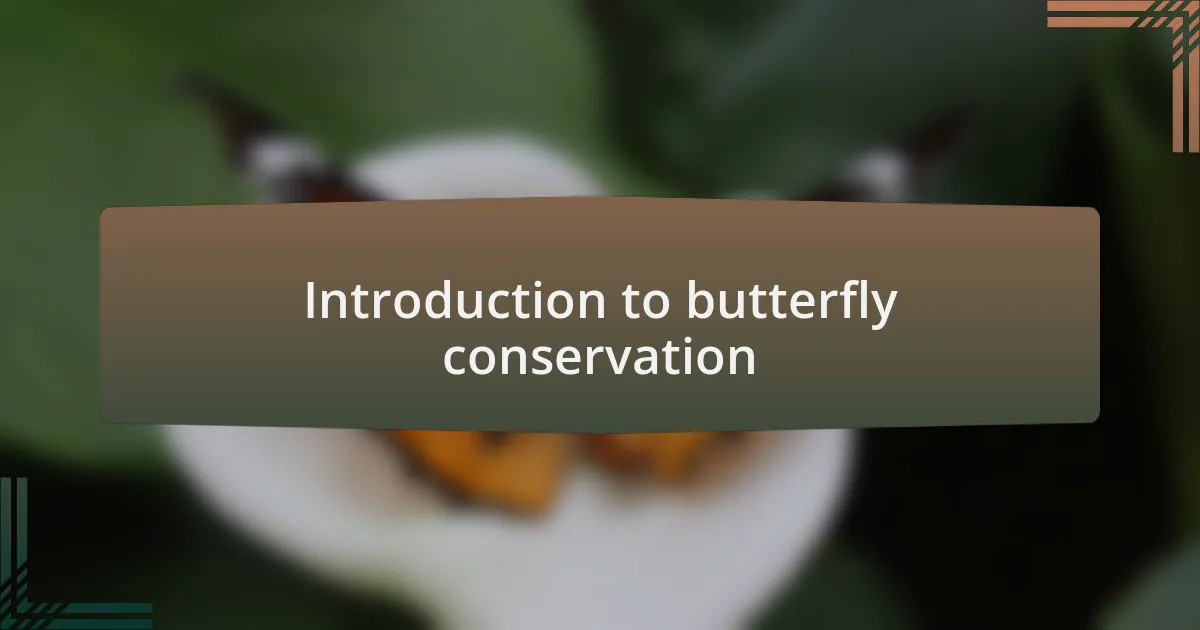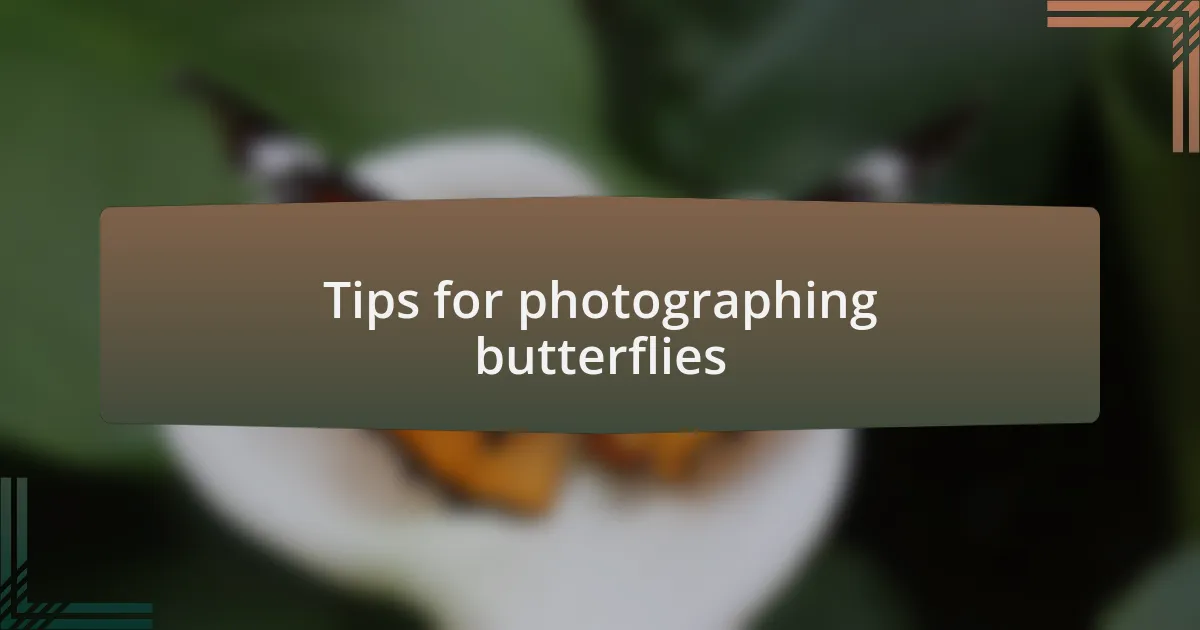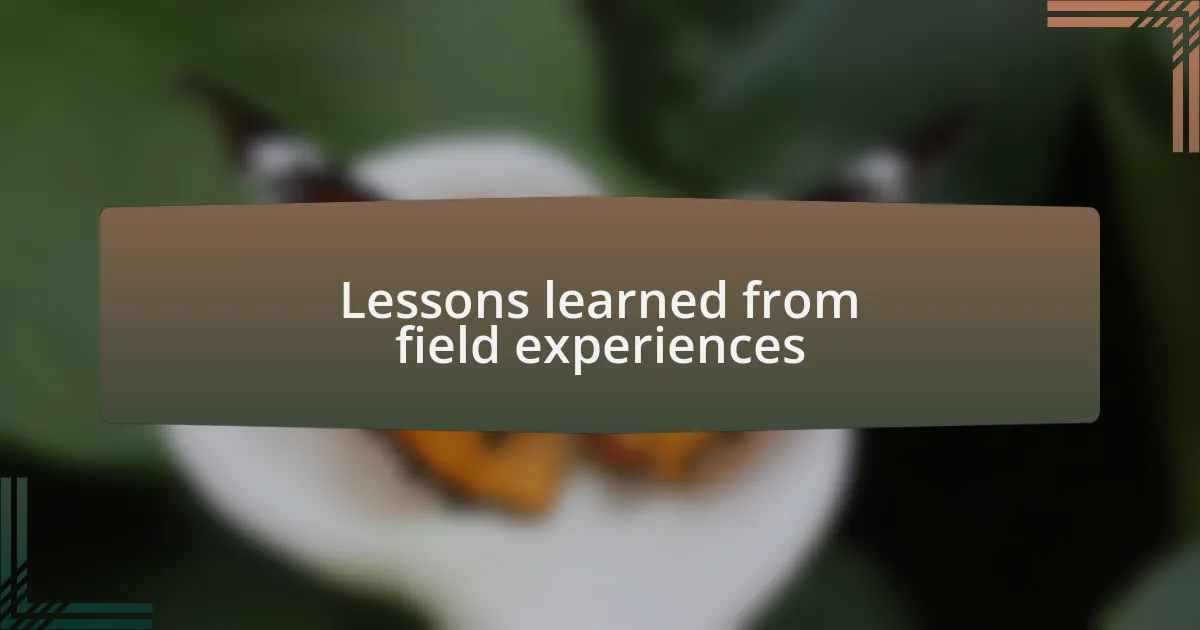Key takeaways:
- Butterflies are crucial pollinators and indicators of ecosystem health, highlighting their importance in maintaining biodiversity.
- Wildlife photography requires patience, understanding of technical settings, and a focus on composition to effectively capture the beauty of butterflies.
- Engaging the public in butterfly conservation through education and creating habitat corridors can enhance efforts in preserving butterfly populations.
- Technology, such as citizen science apps, can play a vital role in monitoring butterfly populations and tracking environmental changes.

Introduction to butterfly conservation
Butterfly conservation is a critical aspect of preserving our planet’s biodiversity. When I first stumbled upon a butterfly fluttering gracefully in my garden, I couldn’t help but marvel at its elegance. This moment made me realize how essential these creatures are—not just for their beauty, but for the crucial roles they play in our ecosystems.
As I delved deeper into the world of butterflies, I discovered that many species are facing severe threats due to habitat loss, climate change, and pollution. Isn’t it heartbreaking to think that the delicate wings of a butterfly can symbolize the fragility of nature itself? My adventures in wildlife photography have shown me how vital it is to protect these environments, where these beautiful insects thrive.
Learning about butterfly conservation has also opened my eyes to how interconnected all life forms are. I often reflect on how my actions, no matter how small, impact these creatures. For instance, by planting native flowers in my backyard, I not only attract butterflies but also contribute to a larger movement of conservation. Can each of us make a difference in our environment? I believe we can, and it starts with simple steps like nurturing butterflies and their habitats.

Importance of butterflies in ecosystems
Butterflies play a vital role as pollinators in our ecosystems. While observing butterflies in the wild, I noticed how they flit from flower to flower, transferring pollen and facilitating the reproduction of many plants. Without these delicate pollinators, many flowers—and the fruits and seeds that follow—would struggle to thrive. Isn’t it fascinating how a creature so small can have such a significant impact on plant life?
Additionally, butterflies serve as indicators of a healthy environment. During one of my photography excursions, I found that the presence of diverse butterfly species often signaled a rich, balanced habitat. As they rely on specific host plants for their larvae, a decline in butterfly populations often hints at broader ecological issues. This connection makes me ponder: how well do we understand the health of our ecosystems just by observing these beautiful insects?
Moreover, the cultural symbolism of butterflies enriches our connection with nature. I recall watching a butterfly land on my daughter’s outstretched hand, capturing her wide-eyed wonder. It reminded me that butterflies are more than just insects; they inspire joy and curiosity, fostering a sense of appreciation for the natural world. When we nurture our relationship with these creatures, we also embrace the responsibility to protect their habitats and, ultimately, our ecosystems.

Basics of wildlife photography
Understanding the basics of wildlife photography begins with patience and observation. During my early outings, I learned that sometimes the greatest shots come from waiting quietly in a field, letting the wildlife become comfortable with your presence. Have you ever noticed how animals can be more relaxed when they sense no sudden movements? Capturing that perfect moment often means becoming part of the environment itself.
The technical aspects, such as knowing your camera settings, are also vital. When I first started, I struggled with understanding the role of aperture and shutter speed in relation to light and motion. I remember a specific day when I missed a stunning shot of a butterfly taking flight because my shutter speed was too slow. It was a reminder that mastery of these basics is essential to seize fleeting moments that can transform an ordinary photo into something truly remarkable.
Lastly, composition is key in wildlife photography. I often think about the ‘rule of thirds’—a technique that helped me frame my shots more dynamically. One memorable photograph I took was a butterfly perched on a flower, slightly off-center, which added depth and intrigue to the image. How do you create a narrative through your images? It’s all about experimenting and finding your unique way to tell the story of the wildlife in front of you.

Tips for photographing butterflies
One of the best tips I can share for photographing butterflies is to focus on the light. I learned the hard way that golden hour—early morning or late afternoon—can transform your images. I once captured a beautiful butterfly as sunlight filtered through its wings, creating a magical glow that made the photo pop. Have you ever noticed how different lighting can evoke various moods in an image? The time of day you shoot truly makes a difference.
Another essential aspect is to get low to the ground. I find that kneeling or lying down often brings a whole new perspective to my shots. I recall a particular moment when I positioned myself at eye level with a butterfly exploring a flower; the intimate view I captured felt almost like a secret the butterfly was sharing with me. Isn’t it fascinating how tiny adjustments in your position can yield dramatically different results?
Lastly, don’t shy away from using a long lens. I remember one sunny afternoon when my longer lens allowed me to snap photos from a distance, without disturbing their natural behavior. That distance helped me capture a series of butterflies dancing around a blooming bush, illustrating their grace and spontaneity. Have you ever been amazed by how tools can enhance your ability to connect with the subject? The right equipment can open up a world of possibilities.

Observing butterfly behavior
Observing butterfly behavior offers a window into their fascinating lives. I once spent an afternoon in a meadow, quietly watching a group of Monarchs as they flitted from flower to flower. It was like witnessing an elegant dance, each butterfly exhibiting its unique rhythm and preference for particular blooms. Have you ever taken the time to notice how some butterflies are more discerning than others about their food sources?
One memorable experience for me was watching a Swallowtail butterfly engage in a courtship display. It spread its wings wide, showcasing its vibrant colors as it circled a potential mate. The sheer joy in its movements reminded me of nature’s own ballet, full of intention and grace. How often do we pause to appreciate the complexity of their interactions, much like our own?
I’ve also learned that butterflies are creatures of habit, often returning to the same spots repeatedly. On one occasion, I observed a Painted Lady that seemed to have a favorite perch on a sunbeam-kissed leaf. I felt a rush of excitement as I anticipated its next visit, watching the delicate creature return time after time. Isn’t it intriguing how these small, seemingly simple creatures can develop routines that mirror our own?

Lessons learned from field experiences
Spending extended hours in the field has taught me the importance of patience and keen observation. One afternoon, I found myself sitting silently beneath a flowering bush, waiting for a fleeting glimpse of a rare species. It was in that quiet stillness that I realized, sometimes the most rewarding moments come when we allow nature to unfold at its own pace. Have you ever found beauty in the moments of waiting and stillness?
I’ve also discovered the significance of adaptability. During a rainy outing, I thought my day was ruined until I noticed a cluster of butterflies sheltering under large leaves. It was a lesson in resilience, as these creatures taught me to embrace the unexpected and shift my focus. Isn’t it fascinating how nature can flip our disappointments into opportunities?
Another vital lesson was the profound connection that develops when we immerse ourselves in nature. I once felt an exhilarating sense of unity when a butterfly landed on my shoulder. It made me reflect on how, in those fleeting moments, I was part of their world, not just an observer. How often do we truly engage with our surroundings, allowing ourselves to experience that rare bond?

Future steps in butterfly conservation
Future steps in butterfly conservation should focus on enhancing habitat connectivity. I remember one summer when I noticed a vibrant butterfly population on one side of a busy road, yet on the other side, the landscape was barren. It struck me then how fragmented habitats can hinder these delicate insects from thriving. How can we inspire local communities to create corridors that connect these vital habitats?
Moreover, engaging the public through educational campaigns can significantly bolster conservation efforts. I had a heartwarming experience one day while leading a workshop on butterfly gardening. Seeing how enthusiastic children were to plant flowers that support local species reminded me of the impact we can have when we share knowledge. Isn’t it empowering to consider how informed individuals can become advocates for conservation through simple actions?
Finally, leveraging technology for monitoring butterfly populations offers promising potential. I once participated in a citizen science project that encouraged folks to document butterfly sightings using an app. This experience opened my eyes to the value of collective data in tracking species trends. How might we innovate further to harness technology in our conservation strategies? These steps can truly transform the future of butterfly conservation.